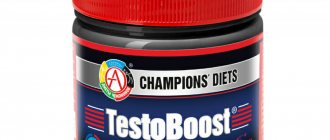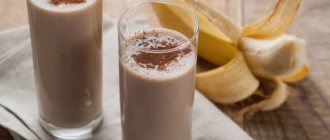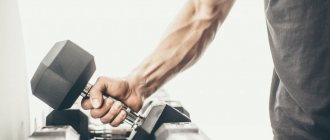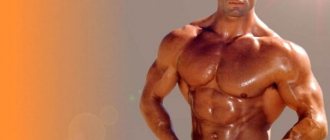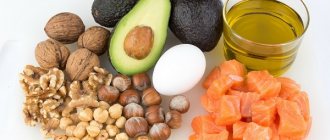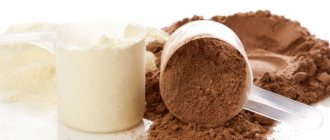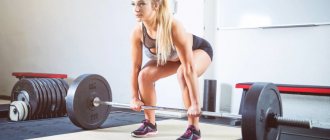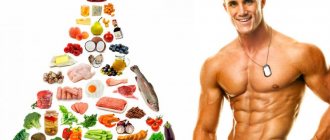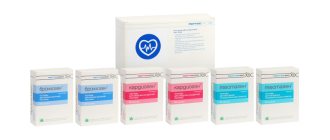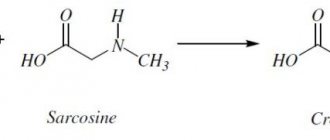The 2,500 calorie per day diet is popular among people who exercise vigorously. A diet with the optimal amount of food and balance of nutrients. Effectively fights fat deposits during physical activity and promotes muscle gain.
A balanced diet and a varied menu allow you not to harm your health. The calorie content of food is a numerical measure of energy that is distributed in the body during the breakdown of food.
Dear readers, we invite you to SUBSCRIBE TO OUR NEW CHANNEL about weight loss and a healthy lifestyle. Useful materials will be published several times a week!
- We recommend reading: 100 calorie diet and 2000 calorie diet
The established calorie intake rate for a woman per day is 1800 kcal, for a man - about 2.5 thousand.
Basic diet rules for gaining muscle mass
During intense training and physical activity, a significant portion of energy is consumed. Costs are covered with food. By limiting your diet, a person will not receive enough substances necessary for weight gain.
The weight gain diet is based on one principle: you need to get more calories from food than you burn. Only by following this rule can you really achieve positive results.
You should also take into account the following several equally important menu rules for weight gain:
- Eat small meals. You need to eat 5-6 times a day. Portions are small. When eating a significant amount of food at one time, the body will not be able to digest all the nutrients. Some vitamins and minerals will be lost, and the muscles will not receive the required amount of energy on time. The rest of the nutrients will be stored in fat deposits.
- There are high-calorie foods. You should eat frequently, high-calorie foods - 70% of the daily diet. If you eat low-calorie foods, your body will not have enough energy. You will have to increase the number of meals, and the digestive organs will be overloaded.
- Limit the consumption of fast carbohydrates and fats. Consumption of such foods leads to an increase in body fat. Fast carbohydrates are flour products, sweets, baked goods, and candies. The calorie content of the food is high and is absorbed instantly. The body does not have time to quickly waste the energy received. Humans need animal fats in limited quantities. Lard and sausages consumed in excess contribute to an increase in fat deposits.
- Consume 2.5-3 liters of water per day. Rapid weight gain is stressful for the body. Accelerated metabolism and increased metabolism require large amounts of fluid. Lack of water will cause disruption of the digestive tract and worsen overall health. Also, with dehydration, muscles will stop growing.
- Receive 70% of calories before 16:00. Afterwards, eat proteins - cottage cheese, eggs, fish. Fast carbohydrates and fats are eaten before 12:00 and are acceptable before training.
- Diet of athletes. Professional athletes eat 2 hours before exercise and 1 hour after. You should eat as well. Constant training and an enhanced diet will accelerate the process of muscle growth.
- Compliance with the principle of the “food pyramid”: 60% - carbohydrates, proteins - 30%, fats - 10%. Most of the carbohydrates consumed are cereals, potatoes, and fruits. Proteins can be obtained from sports nutrition containing protein in the required quantities. Fats – vegetable, animal – in minimal quantities.
Daily value of calories, proteins, fats and carbohydrates
Muscle growth will occur with regular training and sufficient energy. Sports supplements will not provide the optimal amount of calories. To restore the body's strength and increase muscle mass, you need to consume a significant amount of proteins, fats, and carbohydrates.
It is convenient to calculate your daily calorie intake using the Lyle MacDonald formula. To do this, you need to multiply your own weight by 35.
For example, for a guy weighing 70 kg: 70 x 35 = 2450 kcal. The data is based on a thin man with a fast metabolism. By adding 10-20% to the resulting value, you get the caloric intake for weight gain: 2450 x 1.2 = 2940 kcal.
By consuming 2940 kcal per day, the expended energy will be restored, and muscles will gradually increase.
For men
- Protein is the basis for muscle growth. With constant strength training, the daily protein intake will be 1.5-2.5 grams per 1 kg of body weight. Minimum – 150 grams per day. For a guy weighing 70 kg, 175 grams is enough. protein to speed up weight gain. Start with a smaller amount and gradually increase the dose. A sudden introduction of a large amount of protein into the diet will stress the body. Choose animal sources of protein with low fat content: chicken fillet, low-fat fish, low-fat cottage cheese, eggs. Vegetable proteins contained in beans, lentils, sesame are absorbed in full when consumed together with animals. After sports activities, you can drink a protein shake.
- Carbohydrates are a source of vitality; a deficiency leads to depression, apathy, and weakness. When eating to gain muscle, you need 5-6 grams per 1 kg of weight. For a thin man - 420 grams per day. Two hours before training, consume slow carbohydrates (buckwheat, oatmeal, rice), an hour before, an hour after - fast ones.
- Fats are 1-2 grams per 1 kg of weight. Fat intake also depends on age category. Maximum daily dose: up to 28 years – 160 g;
- 29–39 years old – 150 g;
- category 40+ – 70 g.
For women
- With intense training, the body requires more protein. Insufficient protein will affect the condition of the skin, hair, and nails. The minimum daily intake is 1.5 grams per 1 kg of weight: 50 kg – 75 g.
- 55 kg – 83 g.
- 60 kg – 90 g.
- up to 27 years – 118 g.
2500 calorie per day diet
The 2,500 calorie per day diet is popular among people who exercise vigorously. A diet with the optimal amount of food and balance of nutrients. Effectively fights fat deposits during physical activity and promotes muscle gain.
A balanced diet and a varied menu allow you not to harm your health. The calorie content of food is a numerical measure of energy that is distributed in the body during the breakdown of food.
- We recommend reading: 100 calorie diet and 2000 calorie diet
The essence of the diet
Sports and a healthy lifestyle sometimes do not bring positive results in gaining muscle mass. Sports supplements and anabolic steroids cause irreparable harm to health. The 2500 calorie per day diet is a sports nutrition diet aimed at accelerating the process of positive athletic performance.
Benefits of dietary nutrition:
- Price;
- No load on the digestive tract;
- Consumption of nutrients and vitamins;
- Clear power characteristics;
- Ease of use.
The 2500 calorie per day diet is suitable not only for sports enthusiasts, but also for patients with diabetes, with the addition of glucose-lowering oral medications to the diet.
Average nutrient intake for an adult based on 2,500 calories per day:
- Cholesterol – no more than 300 mg;
- Fats – no more than 25 g, of which saturated fats – no more than 25 g;
- Dietary fiber – no more than 25 g;
- Carbohydrates – from 257 g to 586 g;
- Proteins – from 58 g to 117 g.
The diet involves consuming:
- Vegetables and fruits;
- Spices and herbs;
- Vegetable fats and oils;
- Soups, sauces and gravies with the addition of chicken, fish or beef;
- Nuts and seeds;
- Bobov;
- Pasta;
- Sokov;
- Eggs and dairy products;
- Bakery products;
- Honey and sugar.
Menu for every day
The 2500 calorie per day diet involves eating smaller meals. Diet increases the load on the liver, so drinking alcohol is not recommended. It is necessary to consume only organic products. Avoid canned and processed foods, which can cause fat growth.
Breakfast 8:30 am
- 2 boiled eggs;
- 1/2 cup oatmeal or other grains;
- 1/2 cup skim milk with half a teaspoon of flaxseed oil or sunflower oil;
- 1 orange.
Second breakfast 11:30 am (two hours before training)
- 150 grams of tuna or turkey with mixed vegetable salad, seasoned with a tablespoon of low-calorie mayonnaise;
- a slice of black bread;
- 1 banana;
- 6 pieces of almonds;
- 1 tbsp juice.
Lunch 2:30 pm (immediately after finishing training)
- 150 grams of chicken breast meat;
- 3/4 cup chicken rice, pasta or vegetables;
- 1/4 sweet pepper;
- 100 grams of lightly stewed mushrooms;
- 100 grams of chopped carrots;
- Add 1 tablespoon of olive oil to one of the dishes.
Light evening snack 5:00 – 5:30
- 1 low fat yogurt;
- 100 grams of boiled oatmeal.
Dinner 8:30 – 9:00 pm
- 1 chicken breast fillet with salad, dressed with 1 tablespoon of low-calorie mayonnaise;
- 1 slice of bread.
Eating one hour before bed, approximately 11:00 p.m.
- 20 grams of cheese;
- 1 tbsp peanut butter;
- 1/2 cup rolled oats (measured raw or dried);
- 10 pieces of almonds or other nuts;
- 150 grams of vegetables.
Second menu option
Breakfast
- 200 ml milk or tea;
- 60 g whole grain bread with butter.
Lunch
- 100 grams of fresh fruit;
- 50 ml coffee with milk.
Dinner
- Chicken broth with 170 grams of meat;
- 50 grams of rice or pasta;
- 200 grams of fresh vegetables and 100 grams of fruits;
- 70 grams of whole grain bread.
Afternoon snack
Dinner
- 170 grams of chicken fillet with vegetable salad or 70 grams of ham;
- A slice of black bread.
Third menu option
Breakfast
- 200 ml milk or tea/coffee;
- 60 grams of whole grain bread with 50 grams of chicken ham.
Lunch
- 100 grams of fresh fruit;
- 50 grams of coffee with milk.
Dinner
- Chicken or fish broth;
- 175 grams of chicken or fish with 200 grams of vegetables;
- 100 grams of fresh fruit;
- 70 grams of whole grain bread.
Afternoon snack
- 200 grams of milk or tea/coffee.
Dinner
- 1 boiled egg and 1 yolk from the second egg;
- 50 grams of chicken ham and a slice of black bread.
Individual food ingredients can be combined. Avoid carbonated and sugary drinks. A glass of wine contains about 70 calories. You can alternate porridge with pasta, adding a small amount of vegetable oil or butter.
A combination of daily physical activity and special exercises and a diet of 2500 calories per day will increase muscle mass naturally without the use of anabolic steroids . The daily diet was developed by an experienced team of nutritionists.
Dish recipes
Bean soup
You will need: 0.1 kg of green peas, 1 large onion, 0.5 kg of chickpeas, 2 medium carrots, 20 g of vegetable oil, ground black pepper, salt, 1 tsp of soda.
Cooking method:
In the evening, pour cool water over the beans and leave overnight. The next day, drain the water and mix with the required amount of soda, leave to soak for several hours.
Rinse thoroughly with running water. Pour plenty of water over the beans and place over medium heat. Skim off the foam and add chopped onions, carrots, peas and butter. Add salt and pepper to taste.
Cook until done.
Krupenik
You will need: boiled buckwheat or wheat porridge 180 g, sour cream 5 g, sugar 10 g, crackers 5 g, cottage cheese 85 g, egg 1/4 pcs, melted butter 5 g.
Cooking method:
Add cottage cheese, salt, eggs, sugar, butter to the prepared porridge and mix. Place the resulting mass on baking sheets and grease the surface with sour cream. Bake until done.
Potato salad
You will need: 0.5 kg of potatoes, 1 tbsp horseradish, 1 ripe apple, 2 tbsp vinegar, 0.1 kg ham, 2 tbsp vegetable oil, 0.1 kg leeks, 1 tbsp honey, 2 celery roots, salt and pepper.
Cooking method:
Cut potatoes, leeks, celery and apple into small cubes. Mix oil, vinegar, honey and horseradish, add salt and pepper. Pour the resulting sauce over the vegetable salad and leave for 2 hours. Roll the ham into rosettes and decorate the surface of the salad.
On topic: What can you eat after a diet?
Barley porridge
You will need: 2 tbsp butter, 3 eggs, 1 tbsp barley, 1 tbsp sour cream, salt, 1 l milk.
Cooking method:
Important!
Pour hot milk over the washed cereal, bring to a boil and reduce heat. Add butter, sour cream and salt to taste to the boiled cereal. Add eggs to hot porridge and stir. Transfer the porridge to a frying pan or mold. Bake at 150 C for about 15 - 20 minutes.
One serving of the shake contains forty grams of additional protein. To prepare the drink, add 4 tablespoons of powder to a glass of water or milk.
Source: https://BezPuza.ru/diety/po-kalorijnosti/2500-kalorij.html
The Best Foods for Gaining Muscle
An increase in muscle mass is associated with the frequency of meals, caloric content and quality of foods consumed. You cannot save money; an unbalanced diet will have a detrimental effect on the condition of the body as a whole.
Recommended to use:
- Beef is rich in iron, keratin, and protein. Ideal – 200 grams per day, 2 times 100 g.
- Chicken fillet, breast. 300 grams contain 69 g of protein, i.e. half the daily requirement. Use 2-3 times a day in portions.
- Salmon contains protein and amino acids. Promotes recovery after training, reduces muscle inflammation, helps monitor testosterone levels.
- Eggs . When gaining weight, they are second only to a protein shake. Protein is instantly absorbed, breaking down into amino acids. To create a balance between proteins and fats, you need to remove 4 yolks from 6 eggs. This omelet will give the body up to 30 grams of protein.
- Nuts . Mono fats increase the performance of the heart, internal organs, and ligaments. You need to eat about 55-60 grams of various nuts per day: almonds;
- walnuts;
- peanut;
- hazelnut;
- cashew nuts.
- potassium;
Weekly menu for gaining muscle mass
Nutrition for muscle growth must be complete, high-quality, fractional. The diet consists of 3 main meals and 2 snacks.
Features of the menu for weight gain:
- Calorie content – 3000 kcal.
- Water – 3 liters/day.
- Avoid sweets.
An approximate menu option is presented in the table:
| Day of the week | Menu |
| Monday | Breakfast: oatmeal with apples, nuts, toast with cheese, tea. Snack: dried fruits. Lunch: chicken fillet, potatoes, vegetable salad, bread, butter. Afternoon snack: banana, cottage cheese. Dinner: baked salmon, rice, vegetable plate. 30 minutes before bedtime: kefir. |
| Tuesday | Breakfast: Buckwheat porridge with fruits, almonds, milk, bread. Snack: cottage cheese, sour cream, honey. Lunch: cabbage soup with beef, mackerel, baked with vegetables. Afternoon snack: homemade yogurt, bread. Dinner: boiled chicken breast, potatoes, vegetables. 30 minutes before bedtime: kefir. |
| Wednesday | Breakfast: rice milk porridge, 6 egg omelette. Snack: yogurt, raspberries. Lunch: stewed turkey fillet, durum pasta, butter, tomatoes. Afternoon snack: toast with cheese, cottage cheese with jam. Dinner: river trout, brown rice, vegetable salad, sour cream. 30 minutes before bedtime: milk. |
| Thursday | Breakfast: omelette, chicken fillet, steamed vegetables. Snack: smoothie made from milk, banana, strawberries, peanuts. Lunch: boiled veal, grilled vegetables, potatoes. Afternoon snack: salmon sandwich, tomato juice. Dinner: vegetable stew, flounder, peppers, cucumbers. 30 minutes before bed: yogurt. |
| Friday | Breakfast: milk pasta soup, eggs - 2 pcs, cheese, bread, butter. Snack: milkshake, cottage cheese. Lunch: borscht with beef broth, beef, sautéed vegetables, buckwheat. Afternoon snack: nuts, dried fruits, banana. Dinner: mackerel, potatoes, sliced vegetables. 30 minutes before bedtime: kefir. |
| Saturday | Breakfast: oatmeal, milk, banana, strawberries, bread. Snack: cheesecake, homemade yogurt. Lunch: solyanka, vegetables baked with chicken, bread. Afternoon snack: milk smoothie, cottage cheese. Dinner: rice, baked salmon, vegetable salad. 30 minutes before bedtime: kefir. |
| Sunday | Breakfast: buckwheat porridge, omelette, bread. Snack: cottage cheese casserole. Lunch: vegetable soup, veal, pasta, cucumber. Afternoon snack: cottage cheese, jam, kiwi. Dinner: rice, chicken breast, steamed beets. 30 minutes before bed: homemade yogurt. |
How to eat on 4000 calories
The 4,000 calorie per day diet is suitable for young and active people or underweight people who are trying to gain weight for health. While it may be tempting to eat calorie-dense junk food to fill 4,000 calories, eating this way can lead to health problems. Therefore, we advise you to aim for a healthy, balanced diet.
Divide 4,000 calories into six separate meals, each containing 600 to 850 calories. Eat every three to four hours and have a snack, such as a peanut butter or meat-and-cheese sandwich, before bed.
Breakfast (about 820 calories)
- Cup of oatmeal (with low-fat milk, banana and peanut butter)
Optimal time to eat
Nutrition is an important component when gaining muscle mass. Complete assimilation of the received elements will only occur if you adhere to the daily routine, rest, and training.
Before training starts
You should not eat food immediately before training. The optimal time is two hours before the start of classes.
You need to choose foods rich in complex carbohydrates. They will give you strength and energy for the upcoming workout. It is recommended to eat a plate of porridge, pasta, and potatoes. Supplement your meal with fruits, meat, and nuts. It is advisable to drink a cocktail containing proteins and carbohydrates 30 minutes before.
After completing training
Avoiding eating after training is prohibited. This is the ideal moment to fully absorb all the elements necessary to build muscles.
45 minutes after the end of the lesson, you need to eat a few bananas and drink a portion of gainer. The main thing is to replenish lost energy and restore strength. Include foods containing proteins and slow carbohydrates in your diet.
Meal frequency
It is necessary to eat with breaks not exceeding three hours. Eat fully five to six times. An important point is the number of meals and recommended meal times.
The ideal schedule for gaining muscle is presented below:
- Breakfast – 7:00.
- First snack – 11:00.
- Dinner – 14:00.
- Afternoon snack – 17:00.
- Dinner – 20:00.
- Meal before bed – 23:00.
The serving size depends on the characteristics of the body, but the daily calorie content is not less than 1500 kcal for girls, 2500 kcal for boys.
By building your optimal nutrition schedule, you can achieve great results. By following this diet for 90 days, you will develop a reflexive desire to eat by a certain time.
Nutrition for muscle growth
The mistake many beginners make is that they want everything at once. They want their muscles to immediately grow in relief, and the amount of fat to constantly decrease. So, I’ll say right away that this is impossible. These are completely different training and nutrition programs.
By trying to practice according to a universal scheme, you simply delay the result that is significant for you.
To start gaining weight, you have to spend a lot of calories, but you need to get even more, and in order to lose excess weight and work on relief, you need, on the contrary, to “undereat”.
How much and what should you eat?
Each person is unique and each person needs a certain number of calories per day. You can calculate the required number of calories here. The average person needs to eat approximately 2500 – 3000 calories per day. Not so little.
Professionals note that guaranteed muscle growth begins when the number of calories consumed per day exceeds the norm by 500 - 1000 calories.
That is, if you need to eat 3,000 calories a day to maintain body processes, then muscles will begin to grow when you consume 3,500 - 4,000 calories. To obtain this amount of calories, you need to consume a significant amount of food.
Important!
Nutrition for muscle growth is a lot of calories from carbohydrates, so that there is energy for muscle recovery, a large amount of proteins, so that the muscles have something to build from, but you shouldn’t forget about fats either.
Many people are very afraid to eat fatty or low-protein foods. They think they will only get fat and therefore don't eat enough. This is a very common mistake for beginners. Of course, you shouldn’t eat fatty foods on purpose, but this is not a reason not to eat at all.
As Robbie Robinson said, when he began his training as a teenager, he began to eat huge amounts of protein and carbohydrates and did not even think about how much fat he ate. Over the course of a year of training, he gained about 20 kg of weight. Of course, it was not purely muscle, the percentage of fat was quite high.
But this is normal, this is how it should be, otherwise you are just making things more difficult for yourself. Today, when novice bodybuilders come to the gym, they immediately try to work on the relief and consume few carbohydrates, as a result, the energy runs out, there are no results and many give up this business altogether, citing their unsuccessful genetics.
Remember: for muscle growth to begin, you need to overdo it with calories, which are best obtained from complex carbohydrates.
One of the steps to a beautiful body is gaining weight. It doesn't matter how much fat you gain along with muscle. As soon as you gain enough weight, you will begin to work on the relief and lose excess fat.
Muscles cannot work in two modes at once, increase strength, volume and improve endurance, because for different modes they change their structure and principle of operation.
For this reason, we conditionally divide athletes into track and field athletes and weightlifters.
Eat as often as possible
Try to fuel your body as often as possible. This lets your body know that food is always available and it doesn’t need to store fat. Try to eat at least every 2-3 hours. Don't overeat, try to eat as much as you need.
Learn to listen to your body, don’t force food into your stomach. Maybe he's just not ready to accept that much food yet. When you start burning calories consistently, your appetite will appear.
Advice!
Over time, your body will get used to it and will constantly ask for food and, moreover, in large quantities. It will come, in time.
Breakfast, second breakfast, lunch, afternoon snack and dinner - this is the normal diet. After training, you can also drink a protein shake at night depending on how you feel.
Try to shift your carbohydrate intake to the morning and protein intake to the evening. In the morning and at lunchtime, you shouldn’t be afraid of fatty foods; it’s better not to overeat at dinner.
You should not skip meals in the morning, afternoon and evening.
Try to eat more for breakfast, even if at first it seems like you don't want to eat. Breakfast is a very important part of nutrition. It gives you a boost of energy for the whole day.
Eat before bed. If you are about to sleep, eat yogurt, banana, apple. Fruits are good to take in the evening.
I advise you to definitely eat something before going to bed, even if it’s not a big one. Many people, for example, mix cottage cheese with milk and drink it.
This will allow your stomach to work for several hours, and you will reduce your body's morning hunger. While you rest, your muscles will have something to grow from. But this advice is definitely about how you feel.
Many people do not sleep well when they eat at night; this is a matter of habit. For example, I don't have any problems.
What to do if you can’t eat enough at work, at school, or on the road
Such cases also include insufficient stomach capacity. In such cases, it is recommended to use special protein (protein) or carbohydrate (gainer) cocktails. They will allow you to “get” the missing calories for the day.
Products that are recommended to have in the daily diet
Cottage cheese (Better 0.3%)
Milk (preferably skimmed 0.5-1.5%)
Fish (Proteins + carbohydrates + vitamins)
Nuts (Proteins and Carbohydrates)
Bananas (carbs + B vitamins + minerals)
Rice (Carbohydrates. Good for breakfast and lunch, as a side dish)
Porridge, preferably oatmeal (Also high in carbohydrates + vitamins and minerals + fiber. Great for breakfast)
Chicken (High protein, especially low-fat breast)
Vegetables and fruits must be present in the daily diet (various vitamins)
I advise you not to exclude meat and dairy from your diet, since “milk” and “meat” protein are absorbed differently and are certainly needed by your body to gain muscle mass.
Source: https://musclefactory.ru/pitanie-na-nabor-massy.html
Water and its role
Water is an important component when gaining weight. Liquid occupies 65% of the total volume of biologically significant substances. To maintain the balance of H2O in the bodybuilder’s body, you need to consume as much as is lost during the day.
For girls - 2 liters, for guys - 2-2.5 liters.
Drink mineral water without gas, purified, boiled pipeline water.
Water comes in:
- Directly when consumed with liquid — 60%.
- With food (soup, borscht, porridge) — 30%.
- During the digestion process — 10%.
Functions of water
The main functions of water during sports activities:
- Supports organ function. Water carries nutrients to cells, participates in the process of digestion, digestion, and muscle fiber growth.
- Thermoregulation. During training, 75% of the fluid is used for heat exchange, the body produces sweat, which cools. 25% of water is lost during exercise. Up to 2 liters of H2O is lost through sweat in 60 minutes.
- Burning fat deposits. When gaining weight, it is important that the calories gained are converted into muscle and not stored as fat. Drinking half a liter of water 4 times a day can burn up to 100 calories.
- The appearance of activity during training. Dehydration leads to a feeling of fatigue and powerlessness. Water starts processes in muscles due to its significant content in muscle fibers.
- Improving execution technique and accuracy of movements. As a result of a lack of fluid, an incomplete exchange between nerve and muscle tissues will occur. A lack of 3% H2O can reduce aerobic activity by half and training efficiency by 20%. Sufficient fluid intake promotes rapid muscle growth.
- Lubrication of the joint-ligamentous apparatus. During intense training, the load is also placed on the joints. There is always fluid in the ligaments and joints, the flow of which is related to the amount of water drunk. The appearance of thirst indicates a lack of moisture in the body. If you feel the feeling, immediately drink 400 ml of water.
- Water removes fluid from the body. With a constant lack of H2O, the body begins to store it for future use, storing liquid in fatty deposits. Accordingly, the weight goes not into muscles, but into fat.
The required volume of liquid is calculated using the formula: body weight multiplied by 30. With a weight of 70 kg, you need to consume 70x30 = 2100, i.e. 2.1 liters of water per day.
Rules for water consumption:
- Drink 400 ml of liquid 90-120 minutes before training, 200 ml 30 minutes before training. Increase the volume to 800/400 ml in the hot season.
- During exercise, consume 250 ml of liquid every 15 minutes. Per hour of training - up to 1 liter for men, 600 ml - for women. For professional bodybuilders, increase the volume to two liters of water.
- After exercise, you also need to replenish the lost volume of H2O - drink 400-700 ml over two hours.
Lunch
1 medium banana + nuts 50 g + natural yogurt 2.5% fat 200 ml.
One serving contains: 521 kcal | 16 g protein | 33.5 g fat | 10.8 g carbohydrates
Meatballs with cheese
Ingredients for two servings:
- 250 g minced pork and beef
- 1 medium onion
- 40 g large oat flakes
- 50 g of any hard cheese
- salt, pepper, spices to taste
- sunflower oil
Turn the oven on to 200 degrees and let it heat up. Wash, peel and chop the onion as finely as you can. Pour boiling water over the oatmeal so that it covers 1 cm. Cut the cheese into cubes about 1x2 cm. Place the minced meat in a deep bowl, add salt, pepper and, if you want, add spices (basil, oregano, dill, cumin, etc.), onion and squeezed water flakes. Mix the minced meat thoroughly with your hands.
Place the frying pan over high heat and grease it with oil. When the oil is hot, wet your hands with cold water and roll the minced meat into a ball. Flatten it slightly and place a block of cheese in the center, then remember your golden childhood and roll it into a neat sphere, which you then need to put on a hot, oiled frying pan and fry until golden brown on all sides. Process all the minced meat in this way, and then put the fried meatballs in a heat-resistant form, cover with foil or a lid and place in the oven for 10-12 minutes.
One serving (200 g) contains: 593.4 kcal | 40 g protein | 40 g fat | 14 g carbohydrates
Rice with vegetables
Ingredients for two servings:
- 1 cup (200g) rice
- 1 medium carrot
- 1 medium onion
- 1 red bell pepper
- 1 clove of garlic
- 80 g frozen green peas
- 80 g canned corn
- 20 g olive oil
- 400 ml boiling water
- salt, pepper, spices to taste
All vegetables need to be washed, carrots, onions and garlic need to be peeled, seeds and membranes removed from the peppers, nothing needs to be done with the peas - let them rest in the freezer for now. Rinse the rice, and if it is in a bag, boil it as directed on the package.
Grate the carrots on a coarse grater, chop the onion and pepper into pieces of a size you like, and crush the garlic with the flat side of a knife and chop it up a little. The crushed garlic should be placed in a preheated and oiled deep frying pan or pan (it is better to have a non-stick bottom). Fry the garlic for 10-15 seconds, and add onions, carrots and bell peppers. Stirring occasionally, fry this whole bunch for 7-9 minutes, then add ice peas to them and, periodically repeating rotational movements with a spoon inside your frying pan, keep the vegetables over medium heat and covered for another 5 minutes.
If you've used bagged rice, you're at the finish line. You need to combine the finished rice with vegetables and simmer over medium heat for 3-5 minutes. And if you are not looking for easy ways, then put the water to boil, and while it is heating up, add dry rice to the vegetables. When the water boils, reduce the heat under the pan to low and pour in enough liquid to cover the rice and vegetables by two fingers. Close the lid and simmer for 15-20 minutes. You need to stir the whole thing and build a “slide” every five minutes, collecting rice from the edges and lifting it from the bottom. Once all the water has been absorbed, turn off the burner, close the lid and let stand for another 5-10 minutes without heating.
One serving (250 g) contains: 478.4 kcal | 10 g protein | 10 g fat | 84 g carbohydrates
Cabbage and cucumber salad
Ingredients for two servings:
- 200 g Chinese cabbage
- 2 medium cucumbers
- 1/2 green apple
- 1 tablespoon olive oil
- salt, pepper, herbs to taste
Wash everything, peel the cucumbers and apple. Roughly chop cucumbers, cabbage and apples, season with oil, salt and pepper. All.
One serving contains: 74.3 kcal | 1.4 g protein | 5.3 g fat | 4.7 g carbohydrates
List of recommended protein foods
Protein foods are essential for gaining muscle mass.
The best options are recognized:
- Cottage cheese. The fermented milk product contains 20% fast and slow proteins, which are absorbed alternately.
- Meat ingredients: chicken, turkey, beef. They consist mostly of proteins. Almost completely absorbed. Use boiled, steamed or stewed.
- Salmon. Accelerates the metabolic process, increases the growth rate of muscle fibers.
- Fish fat. Normalizes metabolism, is an anti-inflammatory agent, supports the functioning of organs after training.
- Eggs are an optimally balanced food for training.
- Buckwheat porridge. Positively affects muscle growth.
- Milk. Well digestible, contains a lot of protein.
- Fermented milk products: homemade yogurt, kefir.
- Salmon, lean fish. Rich in omega-3 fatty acids necessary for the functioning of the body.
- Sunflower seeds, sesame.
- Fresh tuna.
- Lentils.
Some simple recommendations
Here are some simple tips for gaining muscle mass with minimal fat:
- consume a reasonable excess of calories (KBZHU calculator). This is your body weight times 30 plus 300-500. Aim for a higher amount if you lead a very active lifestyle, and add 100-300 extra calories to your diet if you don't see weight gain within two weeks.
- Eat 2 grams of protein per 1 kilogram of body weight. This is a simple baseline that ensures there is enough material to build new muscle.
- eat foods rich in nutrients. Such as: rice, legumes, lean meats, potatoes, fruits and vegetables.
- add nutrient-dense snacks. If you can't get the calories you need, add bread, peanut butter, protein shakes, fruit juices, avocados, and even the occasional fast food.
- lift weights 3-5 times a week. However, add weight or reps each week on some exercises.
And now about the food. Remember, the most prominent drawn figures only look good because they have a significant amount of muscle tissue. If you constantly think only about maintaining six-pack abs all year round, you will remain small, fragile and weak. And this looks no better than fat deposits. So how do you gain weight? Unfortunately, it is impossible to write an individual plan for everyone. Therefore, to give you some basic ideas, here is a detailed menu for the week. The menu and set of products below are designed for 3.7 - 4 thousand calories per day. That is, it is designed for a large person. Based on it, you can create an individual nutrition plan and menu and do not forget to weigh yourself once a week, measure your waist and neck circumference, calculate your body fat percentage, take photos in front of the mirror: all this in order to track your progress and make adjustments.
List of carbohydrate products
Carbohydrate foods should account for more than half of all food consumed. You need to use slow carbohydrates in food, and try to eliminate fast ones as much as possible.
You can get it from:
- Mushrooms.
- Cereals.
- Durum pasta.
- Legumes: beans, chickpeas, peas.
- Brown rice
- Potato.
- Vegetables.
- Bread.
- Greenery.
- Garlic.
- Fruits, excluding grapes, pears.
It is better to eat the above foods in the first half of the day, 1.5 hours before training. Some carbohydrates can be replaced with a cocktail immediately after training.
List of foods containing fats:
- Almond.
- Cashew nuts.
- Walnut.
- Brazilian nut.
- Hazelnut.
- Mackerel.
- Applesauce pastille.
- Sardines.
- Anchovy.
- Salmon.
- Red meat.
- Ghee, butter.
- Sour cream.
- Cream.
- Salo.
- Crackers, homemade chips.
- Cheese.
- Sausage, balyk.
Nutritional features for gaining lean muscle mass
There are several types of cutting diets:
- Carbohydrate – comes down to limiting the intake of any carbohydrates. It is allowed to eat meat, fish, eggs, green vegetables, fermented milk dishes, and purified water.
- The zone diet is suitable for bodybuilders who train intensively while cutting. The diet is divided into protein, fat, carbohydrate meals alternately and several snacks.
- Paleo diet. The menu includes only natural, unprocessed foods: vegetables, fruits, berries, nuts. Milk, cereals, and sugar are excluded.
- Fractional meals. You need to eat every 2 hours, up to 10 small meals per day. Follow the diet for 5 days, rest for 10 days, eating the same ingredients 5 times a day. This diet option for gaining lean mass is considered the most effective.
The rules of drying for men and women are different, so it is best to consider the features of the diet for each category separately.
Features of the drying diet for women
- It is recommended to consume complex carbohydrates in the amount of 35-40% of the daily diet.
- Fats of 15-20% will help you avoid problems with hormonal levels and the menstrual cycle.
- The basis of nutrition is proteins up to 60%.
- You can suppress the feeling of hunger by using foods rich in fiber: cabbage, bran, zucchini.
- During intensive training, increase water consumption to 2.5 liters per day.
- By gradually reducing the amount of carbohydrate-containing foods, you can really avoid stress for the body. Replace sweets and confectionery with cereals, fruits, and dried fruits.
- 60 minutes before training, you are allowed to drink only sports supplements rich in proteins and carbohydrates.
- Proper weight loss is 2 kg per week. Exceeding the value indicates a decrease in muscle mass; fluid is lost, not fat deposits.
- Eat food 6 times a day in fractional portions with breaks of 2.5-3 hours.
Features of the girls' body:
- Low metabolism. When eating a high-calorie diet, a woman will gain excess weight faster than a man;
- A special storage mechanism in case of pregnancy and childbirth with an excess of carbohydrates will lead to the appearance of fat folds;
- The advantage of the female body is that stored fat, with the right diet in combination with training, will easily turn into muscles;
- The muscle corset is more developed in the lower part. Although changes during drying will be more visible in the area of the arms, face, waist, and chest. Lastly, relief will appear on the legs and hips.
Features of a diet for drying in men
Nutritional features for gaining lean muscle mass for men:
- The diet must be correct . You should consume twice as much carbohydrates as proteins. The optimal ratio of carbohydrates, proteins, fats is 40-30-30.
- There are a sufficient number of foods containing fiber and plant fibers . For example, cabbage, blueberries, legumes.
- Calorie content should not be lower than 2000 kcal. Lower values will result in decreased testosterone. The excess is easy to spend at the gym.
- Water removes toxic substances produced from protein foods from the body. The norm is 3 liters in the cold season, up to 5 liters in the summer.
- The calorie content of each meal is not higher than 450-500 kcal.
The characteristics of the male body are determined by testosterone, a hormone:
- Accelerates muscle growth.
- Affects protein synthesis.
- Affects the distribution of fat deposits.
- Slows down aging.
About 10 milligrams of the hormone are produced per day. You can increase its volume only with proper nutrition, a selected diet, and proper exercise. The use of hormonal drugs will increase endurance, increase muscle mass, but can lead to dysfunction of the male reproductive organ.
At what rate should I gain weight?
An aspiring natural bodybuilder who trains hard and eats right should gain between 10 and 10 pounds of muscle mass in the first year of hardcore training. Athletes with an average level of training and experienced bodybuilders will not gain weight as quickly. According to Casey Butt, a natural bodybuilder can expect the following rates of muscle gain:
- 1 year
– 7-8 kg of muscle mass - 2 year
– 4 kg muscle mass - 3 year
– 2 kg muscle mass - 4 year
– 1 kg of muscle mass - 5 year
– 0.5 kg of muscle mass
As you increase muscle mass, you will inevitably accumulate some fat. A little. Remember, your muscle gain strategy doesn't have to turn you into a sumo wrestler, but you are allowed to gain between 2.5 and 5 kg of body fat per year. Some will gain more fat, some will gain less. If you fear fat and undereat, you will severely limit your potential for gaining muscle mass. Bodybuilding requires creation, and for this you have to eat more. You won't make the most progress if you cut back on your diet. It will take a long time before you see the abdominal cubes again, but by that time you will already become a real muscular monster!
Below is an approximate plan for gaining muscle mass based on your level of physical fitness and existing experience with muscle growth:
- Beginners.
Beginning bodybuilders who have not previously worked on gaining muscle mass should set the bar at gaining 1 kg of total mass per month for the first year. Ideally, this will allow you to gain 8 kg of muscle and 4 kg of fat mass. - Repeaters.
Repeaters (or those who have already gained about 8 kg of muscle mass) should move the bar by 0.5 kg per month, and so on over the next year. Ideally, this would correspond to 4 kg of muscle and 2 kg of fat tissue. - Middle peasants.
In the third year, weightlifters (as well as those who have already gained 12 kg of muscle mass) should set a goal of gaining 1 kg every 3 months. Ideally, this schedule will help you gain 2 kg of muscle and 2 kg of fat mass. - Experienced.
Weightlifters who have passed the 3-year mark (as well as those who have gained about 14 kg of muscle mass) should set themselves the goal of gaining 0.5 kg per two months during the fourth year of training. Under ideal circumstances, this will lead to a gain of 1 kg of muscle and 2 kg of fat. - Advanced.
If you are in your fifth year of training (or longer) or have already gained about 15 kg of muscle mass, you should set a goal of gaining 0.5 kg of total mass every 2 months, and so on for a year. At best, this will allow you to gain 0.5-1 kg of muscle and 2 kg of fat mass.

